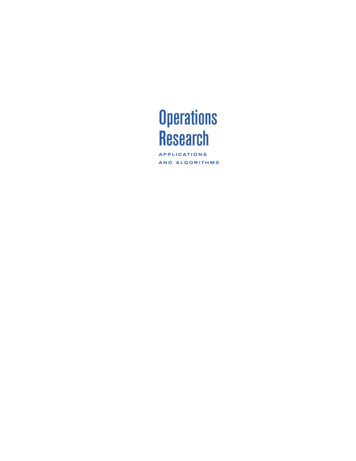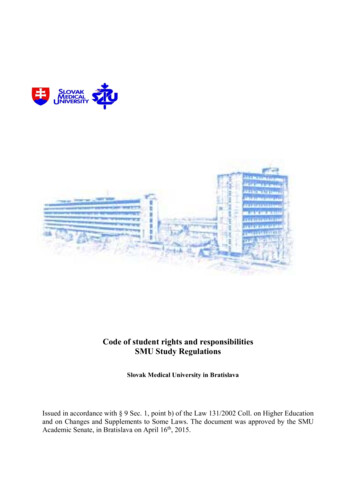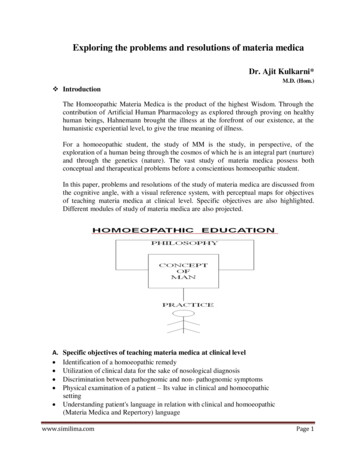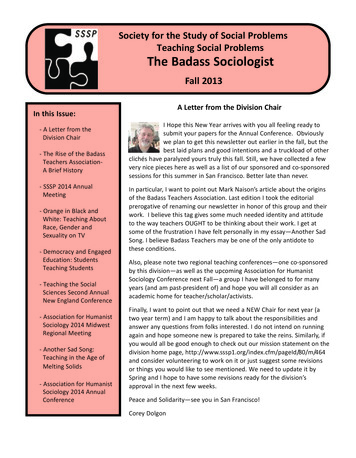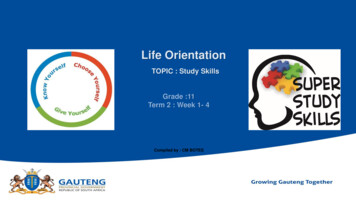
Transcription
International Journal of Pure and Applied MathematicsVolume 119 No. 7 2018, 2415-2427ISSN: 1311-8080 (printed version); ISSN: 1314-3395 (on-line version)url: http://www.ijpam.euSpecial IssueA STUDY ON PROBLEMS AND PROSPECTS OF SILK WEAVERS INTHICO SILKS, TAMILNADU, INDIA.Dr.M.K.Durgamani 1, Dr.M.Ganesan 2,Dr.R.Renuka312Assistant Professor, SASTRA Deemed University, SRC, KumbakonamAssistant Professor, SASTRA DeemedUniversity, SRC, Kumbakonam3Assistant Professor, SASTRA DeemedUniversity, SRC, Kumbakonam.AbstractThis researchpaper aims to examine the expectations of the weavers of THICO Silks Ltd.,and their level of satisfaction. This study also examines the various services offered by the studyunit to its members,the problems encountered by the silk weavers and the various suggestionsoffered to remove the gap between expectations and services offered. From this study it can beunderstand that the weavers facing problems like lack of continuous work, power holidays, lackof expansion and modernization and lack of government support, etc., and the researcherprovides the suitable prospects like the government subsidies, the THICO Silks Ltd., shouldprovide continuous work to the weavers, etc., all the objectives of the study are met. Thereforethe researcher concluded that the weavers of THICO Silks Ltd. are facing problems and thesuitable suggestions are provide for growth and development of them.Key word: Handloom, weavers, THICO Silks Ltd., MembersINTRODUCTIONIndia is an agricultural country. Almost all people rely upon land for their livelihood.The very next occupation where nearly 10 million people depend upon handloom industry. Its3.8 million Handlooms accounting for livelihood of 20 million people scattered all over India.Out of the total 3.8 million handlooms, about one third has been covered by the co – operativesector of the total Handlooms in India about 72 percent are engaged in cotton about 16 percent insilk weaving and the rest are related to Art silk and mixture.REVIEW OF LITERATURE:Many studies have been conducted on various sectors of textile industry at internationaland national levels. Some of the important studies reviewed here:1The authorobserved that various government policies towards handloom industry were abundle of contradiction. Further he observed that the government has spent huge resources toagricultural sector and other large scale sectors, and neglected the handloom sector. It is thecause for the main problems of handloom sector. He suggested that the government should givepriority to prepare plans and allot huge resources to handloom sector.2415ijpam.eu
International Journal of Pure and Applied MathematicsSpecial Issue2The objectives of the study are to bring out the cost structure of the silk yarn and toanalyse the financial management of the silk cooperatives in Thirubuvanam. He has selectedfive silk weavers’ cooperative societies in Thirubuvanam for his study. He observed that thecapital structure of the cooperative silk societies is imbalanced and there is scope forimprovement. He concluded that two societies are doing well and other three societiesshowsnegative result, indicating its failure to adopt the techniques of financial management. Hesuggested that efforts should be made to increase the profitability utilizing the existing resourcesthrough capacity utilization, control over operating expenses and redemption of loans obtained athigher rate of interest. He also stated that the involvement of government and its share towardsthe productivity should be increased considerably.3The handloom industry in Tamilnadu faced the problem of lack of financial facilities3.The commercial banks and District Central Cooperative Banks failed to provide sufficientfinances to the weavers’ Cooperative societies. As a result of this the cooperative movement inTamilnadu, failed and more number of cooperative societies run on dominant lines. At the sametime, the unexpected growth of power looms is the cause of artificial scarcity of yarn. There is agreat need to develop the industry; hence, the government should supply yarn to handloomsector.4The Study has outlined that the textile industry has been experiencing a high cost ofproduction over the years. He suggested that the industry should take the result oriented actionsto control the cost of production and strengthen its research and development area in this regard.5The authorhas stated that the handloom sector has been experiencing a lot of difficultiesin marketing its products. He suggested that in order to make the handloom sector highlycompetitive and sustainable, the government should work out a long-term feasible solutionwhich remove all the hurdles that the handloom sector has been facing all over the years.6The textile industryIndia and China are compared and the relative merits and demerits intextiles between both countries are compared. He outlined that China was much ahead of India intextile industry due to availability of cheap labour, sourcing of good quality of raw materialsneeded for the textile industry at cheap cost and adoption of modern technology and innovation.The author suggested that India should learn more from China and adopt the same in order toimprove its textile industry.7In this study, the marketing problems faced by handloom units in Andrapradesh ispointed out. She suggested the critical problems, such as poor working capital management, lackof product diversification, stiff competition from power loom units and mill sector, lack of accessto bank credit at favourable terms and frequent fluctuations in the prices of raw materials whichhave been daunting the handloom sector for many years. She suggested that innovative productdesign, easy access to credit at favourable terms and adoption of latest technology were the onlymeasures to be adopted by handloom sector in order to come out of marketing crisis.8The measures taken by the Government of India are listed to modernize the power loomsector in order to make it competitive both domestically and internationally. Various task2416
International Journal of Pure and Applied MathematicsSpecial Issuecommittees were set up by Government of India to streamline the complicated procedures thepower loom sector has been facing and to chalk out hassle-free procedures. He suggested thatinfrastructure of power loom sector should be strengthened and the Government of India has amajor role to play in this core area.9Various functional problems that has been experiencing by Erode Hand LoomCooperative Societies are outlined and critically the problems are pointed out, such as poorquality of looms and lack of product diversification among all the problems. He suggested thatthe quality of looms can be made good by resorting to latest technology and strongly advocatedthat hand loom units must focus on creativity to diversify its product in order to solve theproblem of lack of product diversification.10The glory of handloom products are outlined which has been thriving in India forinnumerable number of years. She also categorically spelt that handloom products in India havegrown with Indian culture. The handloom products have been taken as the rich tradition thatpeople of the country adore. She finally suggested that, despite the competition from powerloomand mill sector, handloom products has carved a unique place in the society despite a littlegovernment patronage.11This study have explained the need for establishing more training institutes in India toprovide training to the workforce to be employed by the textile industry. They felt the existinginstitutions in India were offering only very few training programmes which consideredinadequate to train the labour to the textile industry. As a result, the industry was absorbinglabour force into it without formal vocational training which hit the performance of textileindustry so badly.12The study dwelt upon the various measures and initiatives taken by the government toinfuse fresh blood to the handloom sector in order to face stiff competition in export markets.Among the measures, capital subsidy, the Technology Up gradation Scheme, opening more yarndepots, the handlooms (Reservation of Articles for production) Act were noteworthy to mention.He felt that, with the government support, the handloom sector will flourish both in domesticmarkets and export markets in future.13This study have discussed the initiatives of the Indian government to boost thecompetitiveness of its textilesector. It has framed a scheme of Neighbourhood Apparel andTextile Training Institutes for Job Assurances (NATIJA) for training of workers, and is framinga strategy for market expansion and product diversification to facilitate greater value realizationfor products and better market access. The Government of India also plans to revitalizehandloom cooperatives in the pattern of agricultural cooperatives and had announced a reliefpackage which reduces basic customs duty on certain items relating to textilesector as refund ofservice tax paid by exporters on taxable services linked to exports.2417
International Journal of Pure and Applied MathematicsSpecial Issue14He attempts to familiarize with the current status and livelihood problems ofunorganized women handloom workers and argued on the importance of social security. Theauthor pinpointed the condition of women for weaving and the reasons why they diverted toweaving in a much generalized form, He also took up the issue relating to health a womenweaver faces. The study lacks the specific points which can be noted alongside the datacomprises Pan15examined the Indian Handloom in context of Globalization, It has been believed by theauthor that design process help weavers to identify opportunities hence the design program hasbeen conducted in 6 handloom clusters of Assam. The paper aims at producing a sustainablebusiness plan which comprises mainly the marketing plan to assist the competitiveness of clusterin the ever challenging market.The above studies concentrated on various sectors of textile industry. Few studies havedealt with the performance of handloom, knit wears and power loom of textile industry. Thestudies rarely highlighted the problems and prospects of silk weavers in THICO Silks ltd. Therewas no comprehensive study to realize the problems and prospects of silk weavers in THICOsilks Ltd.STATEMENT OF THE PROBLEM:THICO Silks Ltd., weavers suffer many problems like low productivity resultingin poor earnings, shortage of working capital, high incidence of un employment, lack of adequateinstitutional support in raw material, technology.In this research study, the researchers have identified the attitude of weaver’sperformance, level of satisfaction and the problems faced by the weavers of Handloom industrySCOPE OF THE STUDYThe present study has been an in-depth study relating the Members (weavers’) of THICOSilks Ltd. Thirubuvanam. This study would confine to services offered by the THICO Silks Ltd.to its weavers, expectations of silk weavers of THICO Silks Ltd., problems encountered by thesilk weavers with THICO Silks Ltd. The inferences drawn through the analysis is led to valuablefindings which paves way for suitable suggestions for growth and development of silk weaversin THICO Silks Ltd. in the days to come.OBJECTIVES OF THE STUDYThis paper aims to examine the expectations of the weavers of THICO Silks Ltd., andtheir level of satisfaction. This study also examines the various services offered by the study unitto its members,the problems encountered by the silk weavers and the various suggestions offeredto remove the gap between expectations and services offered.2418
International Journal of Pure and Applied MathematicsSpecial IssueHYPOTHESESThere is no significant association betweendemocratic factors of respondents and level ofsatisfaction of respondents with services provided by the THICO Silks LtdSOURCES OF DATA:Survey method has been followed for the study both Primary and Secondary sources ofdata were used. The Primary data were collected from the Well Structured Schedule from theweavers’. The Secondary data were collected from the Books, Journals, Web Portals and variousunpublished records of THICO SILKS, etc.,TOOLS FOR DATA COLLECTION:The primary data was collected through the Interview schedule method consist ofoptional type and Likert’s 5 point scale type questions. The schedule covered the questionsrelating to demographic profile of the silk weavers of THICO Silks Ltd., profile of silk weaversof THICO Silks Ltd., level of satisfaction of silk weavers with services offered by the THICOSilks Ltd., problems faced by the silk weavers of THICO Silks Ltd. and silk weavers expectationtowards betterment of silk weavers of THICO silks Ltd.SAMPLE SIZE:In THICO Silks Ltd. contributes significant percent of total number of silk weavers inThirubuvanam, it has been chosen for the study. 147 silk weavers of THICO silks Ltd.wereselected for the study.SAMPLING TECHNIQUE:The TIPPET’S TABLE Under the Simple Random Sampling Method was used to selectthe respondents in THICO SILKS Ltd.STATISTICAL TOOLSThe primary data collected from the respondents were analyzed with the help ofStatistical Package for Social Sciences (SPSS). The following various statistical tools wereapplied for the present study.Percentage analysis, Friedman’s Test, Cluster analysis; andNonparametric Chi-square test and one way ANOVA.SIGNIFICANCE OF THE STUDYThis would underline the necessity of identifying the nature of weavers and problems ofweavers’ in the silk society and suggest suitable measures for copying with the problems.LIMITATIONS OF THE STUDY:2419
International Journal of Pure and Applied MathematicsSpecial IssueThe research area of the study was restricted to members of THICO Silks Ltd. only.Theinformation provided by the silk weavers of THICO silks Ltd. was purely based on theirperception only. The quality and reliability of the data collected were the actual expression ofrespondents.CLASSIFICATION BASED ON SILK WEAVERS’ SATISFACTION WITH SERVICESPROVIDED BY THE THICO SILKS LTD.In this section the classification of different type of clusters based on silk weavers’satisfaction with services provided by the THICO Silks Ltd. K-means cluster analysis is used toidentify heterogeneous groups of silk weavers’. This analysis is helpful in identifying differentgroups of silk weavers’ with homogeneous qualities.TABLE – 1Final Cluster CentersClusterVariablesHighMediumLowSupply of raw materials2.913.002.53Wage structure4.642.063.73Bonus schemes4.593.752.76Loan facilities4.064.033.07Medical facilities3.793.792.22Government for the weavers’2.212.211.47Technical support3.263.262.47Availability of weaving assistants3.973.973.69Pension schemes4.534.532.69Dividend payments4.704.704.53Source: Primary Datathe first cluster is called a high cluster with high level of silk weavers’ satisfaction with theservices provided by the THICO Silks Ltd. The second cluster is called moderate cluster with themoderate level of silk weavers’ satisfaction with the services provided by the THICO Silks Ltd.The third cluster is called a poor cluster in which the silk weavers’ have low level of satisfactionwith the services provided by the THICO Silks Ltd.2420
International Journal of Pure and Applied MathematicsSpecial IssueTABLE – 2Silk Weavers’ Satisfaction with services provided by the THICO Silks Ltd.2.8163StandardDeviation1.30342MeanRank4.15Wage structure3.80271.274836.26Bonus schemes3.84351.327796.32Loan facilities3.74831.096975.87Medical facilities3.22451.237524.92Govt. assistance for the weavers1.96601.178662.57Technical support2.97281.181744.26Availability of weaving assistants3.89800.934396.29Pension schemes3.85031.336296.37Dividend payments4.64630.765737.98VariablesMeanSupply of raw materialsChiSquaredfSig396.499.000Source: Primary DataThe results of Friedman’s Chi-Square test showed that there is a significant difference in thelevel of satisfaction of silk weavers with the services provided the THICO Silks Ltd. (χ2 396.49,P 0.05). The mean ranks revealed the fact that the silk weavers of THICO silks are moresatisfied with the payment of dividends (Mean Rank 7.98), reversely weavers are highlydissatisfied with the Government assistances to silk weavers (Mean Rank 2.57).PROBLEMS ENCOUNTERED BY SILK WEAVERS IN THE THICO SILKS LTD.There are various key factors which have a direct bearing on the problems of Silkweavers’ of THICO Silks Ltd. Hence, in this regard, Friedman’s test has been used to identifypredominant problems among silk weavers’ of THICO Silks Ltd.TABLE – 3Problems faced by silk weavers’ of THICO Silks quaredfSig
International Journal of Pure and Applied MathematicsSpecial IssueNon-availability of raw materials3.55101.350724.78Lack of expansion and modernization3.17691.242523.82Higher rate of interest on loans2.73471.245963.19Power holidays5.0000.00007.80Labour problems3.98641.297985.68Lack of government support4.77550.617067.27Price fluctuations in raw materials5.00000.00007.80Weather condition lack3.02041.514633.96Lack of continuous work4.46940.821846.50Lack of awareness of welfare schemes3.25851.485494.20559.349.000Source: Primary Data.The results of Friedman’s Chi-Square test showed that there is significant difference inthe problems faced by the weavers’ of THICO Silks Ltd. (χ2 559.34, P 0.05). The mean ranksrevealed the fact that the weavers’ of THICO silks Ltd. are greatly affected by power holidaysand price fluctuations in raw materials followed by lack of government support.WEAVERS’ EXPECTATIONS TOWARDS BETTERMENT OF SILK WEAVERS’ OFTHICO SILKS LTD.The expectations of weavers’ to have betterment of handloom sector have been elicited.This exercise will bring to light the need for improvements to be made by various agencies andthese expectations will form the basis for the authorities to frame effective policies and programsto help this sector to come out of dark days. In this regard, Friedman’s Test (non-parametric) hasbeen employed.TABLE – 4Weavers’ expectations from the THICO silks anDfGovernment's incentives andsubsidies3.0000.000005.75Technological up gradation2.9184.274745.34Access to bank loans at cheaper rates2.9320.252655.412422Sig
International Journal of Pure and Applied MathematicsSpecial IssueSimplification rules and regulations toloan accessibility2.9320.252655.41Uninterrupted power supply3.0000.00005.75Long-term loans for expansion andmodernization2.8707.336635.11Continuous work3.0000.00005.75Training to handle the new productionmethod2.8980.303745.24Housing facility3.0000.000005.75Weaving park2.9456.227625.4866.7389.000Source: Primary DataThe results of Friedman’s Chi-Square test explored that there is a significant differencefound among the various expectations of silk weavers’ of THICO Silks Ltd. (χ2 66.738,P 0.05). The expectations given by the silk weavers’ of THICO Silks Ltd.ranked according tothe order of priority as felt by themselves. At present, the government’s incentives and subsidies,technological up gradation, simplification of rules and regulations to loan accessibility,uninterrupted power supply, Housing facility are the prime expectations of the weavers’ of theTHICO silks Ltd.Table – 5Comparison between weavers’ experience with their Satisfaction, Problems andExpectations in THICO silks ltd.ExperienceNumber ofMeanStandardDeviationRespondentsANOVAF ValueSig.Silk Weavers’ Satisfaction with services provided by the THICO Silks Ltd.UPTO 10 years824.62506.3681710-20 years4325.60474.5833020-30 years4125.12206.17736ABOVE 30 87.429.000Problems faced by silk weavers’ of THICO Silks ltd.UPTO 10 years817.87503.3990510-20 years4319.46514.0552720-30 years4120.85374.27528ABOVE 30 years5522.83643.9523314721.02724.30983Total2423
International Journal of Pure and Applied MathematicsSpecial IssueWeavers’ expectations from the THICO silks ltd.UPTO 10 years811.37501.7677710-20 years4313.76742.3987820-30 years4114.56102.55977ABOVE 30 000The results of ANOVA depicted that the satisfaction level had significantly differ among theproblems and expectation of weavers. Their level of Satisfaction was not significant. Thesignificant value was more than 0.05 (P 0.05). The mean scores of 10 to 20 years of experiencedweaverswas (25.6047), above 30 years of experience shows (22.8364) and they have highexpectations (16.7636). This indicate that the weavers those who have more than 30 years ofexperience face more problems.MAJOR FINDINGSThe discussions highlight the demographic characteristics of the respondents, that Majority of ofthem were male, Maximum numbers of respondents were falls under the age group of above 50years, Most of the respondents (95.9 percent) were married, The maximum numbers ofrespondents were studied Upto SSLC, More than 70 percent of them were in Nucleus family,The study point out nearly 38 percent of the respondents had an experience of Above 30 years.More than 95 percent of the respondents’ handloom location was attached to their residence,Most of the respondents family, 2 members got membership in THICO Silks Ltd., In the analysiswe found that 147 respondents have not membership in any other co – operative society, Morethan 50 percent of respondents’ family, nearly 2 – 3 family members involving in weaving,Majority of the respondents required to complete a single silk saree on more than 7 days, Fiftypercent of the respondents were desire to change the design the silk saree frequently, Most of therespondents do not have restrictions in producing the silk saree, The study inferred that theTHICO Silks Ltd., pay advance money to the weavers, More than 95% of the respondents saysthat the THICO silks Ltd., allows the members to express their opinion in problems in AnnualGeneral meeting. Level of satisfaction of silk weavers are more than 80 percent of therespondents were satisfied with the dividend schemes. More than 70 percent of the respondentswere dissatisfied with the government support. The problems encounter the weavers are 100percent of the respondents were strongly agree with the power holidays and price fluctuations inraw materials. More than 30 percent of the respondents were strongly disagree and disagree withHigh rate of interest on loans and lack of awareness of welfare schemes. Their expectations are100 percent of the respondents mostly needed the government incentives and subsidies,uninterrupted power supply, continuous work, and housing facility. More than 60 percent of therespondents not needed the weaving park and training to handle the new production unit.SUGGESTIONS AND CONCLUSIONThe THICO Silks Ltd., may provide continuous work to weavers, make anarrangement for provisional store facility, quarters facility, medical facilities, providebank loans and give the technical support to silk weavers and improve their standard ofliving. From this study it can be understand that the weavers facing problems like lack ofcontinuous work, power holidays, lack of expansion and modernization and lack of2424
International Journal of Pure and Applied MathematicsSpecial Issuegovernment support, etc., and the researcher provides the suitable prospects like thegovernment subsidies, the THICO Silks Ltd., should provide continuous work to theweavers, etc., all the objectives of the study are met. Therefore the researcher concludedthat the weavers of THICO Silks Ltd. are facing problems and the suitable suggestionsare provide for growth and development of them.LIMITATIONS OF THE RESEARCHThe research area of the study was restricted to members of THICO Silks Ltd. only.Theinformation provided by the silk weavers of THICO silks Ltd. was purely based on theirperception only. The quality and reliability of the data collected were the actual expression ofrespondents.REFERENCES:1. Arulanandum M A, A study of handloom industry in Tamilnadu, Unpublished Ph.D.,Thesis, Madurai Kamaraj University, 1980.2. Kumararaj. V, A study on the Financial Managament of Cooperative silk societies inThirubuvanam, Unpublished Ph.D. Thesis, Bharathidasan University, Thiruchirappalli,1995.3. Alagar.P, Problems of Handloom Industry in Tamilnadu journal of cooperation, 1991,pp.15-26.4. Rao JV, Cost Control Alternatives for the Textile Industry, The Hindu, 2001 Oct., 15,p.15.5. Ramakrishna Rao B, Marketing Miseries of Indian Handlooms,Kurukshetra, 2001 May,p.32.1. Joshni K.N, Comparative Viability of Textile Industry in India and China, TextileManagement Review, 2002, Vol.4 (1), pp.4-7.2. Kanaka Durga K, A study of Marketing of Handlooms in Andhra Pradesh, Indian Journalof Marketing, 2003, Vol.32(12), pp.21.3. Sarkar, R.K, Modernisation of Powerloom Sector, Man-Made Textiles in India,2003,Vol. 45(8), p.287.4. AlexandarPravinDurai F.R, A study on the Functional Problems Faced by the HandloomCo-operative Societies in Tamil Nadu, Indian Journal of Marketing, 2005, Vol.35 (6),p.15.5. Charulata Singh, Handlooms as a Means of Expression, Yojana, 2007 July, p.12.6. Rakshit, Arup K, Training Need for Textile Industry, Textile Review, 2007, Vol. 50(2),pp.43-45.7. Satyasundaram I, Handlooms in the Doldrums, Facts for you, Feb 2008, pp.32-358. Rakshit, Arup K, Recent Government Initiatives for Textile Industry, Man-Made Textilesin India, 2009, Vol. 51(1), pp.3-5.9. Premsundar, B., &Kannah, J. WOMEN IN HANDLOOM INDUSTRY: PROBLEMSAND PROSPECTS. EPRA International Journal of Economic and Business Review,(2013), Vol. 1(1), 32-38.2425
International Journal of Pure and Applied MathematicsSpecial Issue10. Mondal, A. Design approach to enhance manufacturing efficiency of the handloom sectorin Northeast Zone. Lecture presented at Indian Handloom Textiles in the Context ofGlobalization‖ - National Seminar (2015, June).WEBSITES:1. www. Thicosilks.com2. www. Wikipedia.org3. p-tamilnadu/thicosilks/article3538390.ece2426
2427
2428
silk weavers with THICO Silks Ltd. The inferenc es drawn through the analysis is led to valuable findings which paves way for suitable suggestions for growth and development of silk weavers in THICO Silks Ltd. in the days to come. OBJECTIVES OF THE STUDY This paper aims to examine the expectations o f the weavers of THICO Silks Ltd., and

